
by Jodi Amendola | Sep 14, 2016 | Blog
I often tell my clients that selecting a PR agency is much like selecting a spouse. It’s an intimate relationship; we often talk with our own clients several times a day on the phone and email, so we know how important it is for agencies and their clients to “click.”
As for finding this perfect PR match, it’s a lot like real life dating. Sure, an online search can reap lots of possibilities, but referrals from people you know and who know the other party are often the most effective way to find the agency just right for you. So be sure to ask your colleagues, strategic partners and industry editors who they’ve worked with in the past.
After you’ve identified a viable candidate, do your due diligence to confirm it really is a match made in (business) heaven. With 25 years of experience running a successful PR agency, I’ve narrowed this vetting process down to 7 key factors.
Expertise
Do you need an agency with experience in multiple verticals or do you want an agency in a specific market niche such as healthcare IT (HIT)? With the latter, you’ll get knowledge that’s both broad across different niches within that space and deep a combination which uncovers many more messaging opportunities and angles. Such an agency is going to have more relationships with HIT media and digital influencers, along with media experience and skills in national and local markets.
But don’t just take the PR agency’s word for how experienced its team members are find out how long the agency has been in business and be sure to review customer case studies. If possible, seek a conversation or two with the agency’s clients.
Size
It’s amazing to me that some companies, even really small start-ups, think they need a “large” agency to succeed–the “nobody ever got fired for hiring IBM” mentality. I have heard so many clients and prospects describe their experiences working with a large PR agency and their inevitable discovery that the agency viewed them as one of the smaller fishes in the pond. How much attention do you think these companies ended up getting?
There are some companies who start with a small or medium PR agency and then become so big that they do in fact need a large, global partner or multiple agencies and very often, it was the dedication of an independent agency that helped get them there. So when it’s time to hire your next PR agency, make sure to scope out how much personalized attention you’ll get. Ask how many people will be on your team, and their different levels of expertise. Find out their roles and responsibilities and get a good sense of how much access you’ll have to each one.
Location
In the old days before email, Skype, web conference calls and the like, companies largely felt they had to work with agencies in their town or state. But that’s no longer the case. Today companies can communicate and work with any agency in the world, meaning they have exponentially more agencies to choose from. Of course, time zones are a consideration, so you’ll want to seek a PR agency with staff located in all zones. But aside from that, you now have so many more agencies to choose from. So many choices can be overwhelming, so again narrow them down by how well an agency meets the criteria I’ve outlined for you. It really does work!
Range of Services
It’s so much more convenient to work with an agency that offers a roster of services that clients can choose from, either a la carte or integrated. Look for a PR agency that can offer media relations, social media, PR strategy, content marketing, digital marketing, and writing at a minimum. Ask about their connections with video production firms, graphic design and other auxiliary creative services. An experienced agency will either offer these services themselves or have numerous connections on hand they can refer you to and work with on your various campaigns.
Partners
On the subject of agencies working with other creative groups, choose one that can collaborate not compete with your existing agency partners. This is important for integrated campaigns that are executed by multiple agencies to actually work.
Team
Here’s something you might not discover until after you sign the retainer contract with some agencies: very often the high-level execs you met at the presentation aren’t the team who will be working on your account. That’s unfortunate, because experience and compatibility matter. Ideally, at the initial presentation at least one of the people who will be on your team should be there. Do you feel a connection with them? Are they someone you would enjoy working with on a regular basis? Remember this is going to be a close relationship. There are days when I speak with my clients more than with my own husband!
Budget/terms/scope of work
When evaluating agencies you will want to compare apples to apples in terms of services, quantities/deliverables, etc. Are you going to engage in an annual retainer program or a PR project? Will you be billed by the hour or by scope of deliverables? Based on my experience, the latter will get you more value. Teams won’t be clocking out the second your hours for the month are used up; instead, they’ll work tirelessly to successfully execute your campaigns with no limit to the time they put in.
Most PR agencies, if they have hit your top 5 or 10 list, are probably going to be solid contenders. They can all probably write a solid press release and know the nuts and bolts of working with the media. But hone in on how they’ll work with you. Zero in on the fit. Does it feel right? Is this the company that you want to serve as an extension to your own team? As with all other relationships, this comfort level is the key to finding your PR agency soul mate.
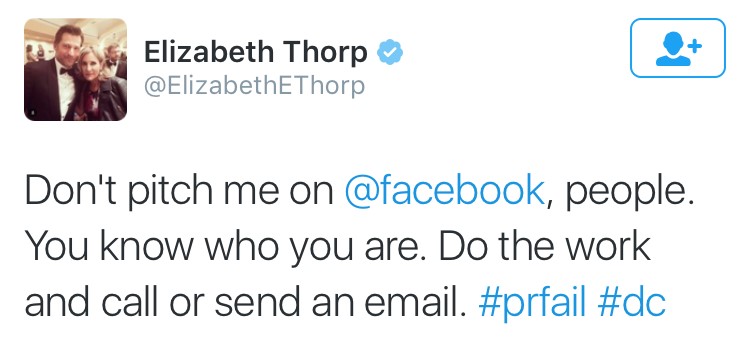
by Stephanie Fraser | Sep 7, 2016 | Blog
The success of any PR pro hinges greatly on their relationships with journalists. These relationships do not occur overnight, and are gradually built on trust, respect, an understanding of journalists’ needs, and their knowledge of the industry. But as anyone in PR knows, that magic formula doesn’t lend itself to every press release, product launch or client award. That aside, understanding a few basics and avoiding some of these “loathsome” PR practices will help foster a positive, ongoing media relationship and save your reputation in the process.
Be cool. “So, did you receive my email?” Don’t call a reporter an hour after you sent an email to follow-up. Journalists are under enormous pressure and numerous deadlines on any given day, so allow ample time between sending a pitch and calling. Chances are, if you didn’t receive a bounce back, they received it. And if the pitch is relevant (and interesting), you’ll hear back.
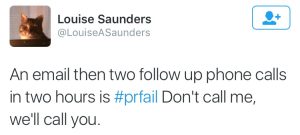
Don’t spam. Nothing makes journalists madder than mass emails. Sending multiple pitches and pitches via a database system can be dangerous. Spend the necessary time to send personalized, targeted pitches and keep track of those you’ve reached out to.
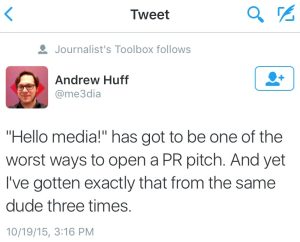
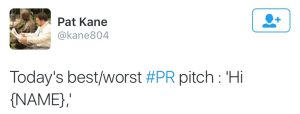
Do your homework. Sending every release to every reporter in the abyss is a no-no and a sure-fire way to be blacklisted. Only send your press release to those contacts with a definite interest in the subject and industry.
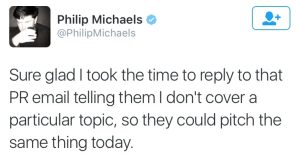
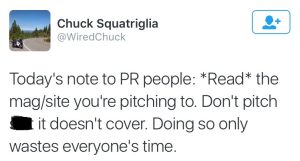
Don’t ask when the story is going to be published. Your client just finished a great interview and you end the call with, “when can we expect to see to this published?” Blah. Reporters typically don’t have control over publishing and are working on several stories a day – including breaking news. Make use of Google Alerts and be sure to check the news outlet several times a week to monitor the article. If a month or so has passed since your client’s interview, then you have the green light to make a follow-up inquiry.
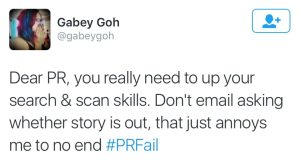
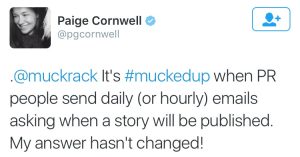
Don’t quote anyone that can’t be contacted. If you are sending out a release that includes quotes from the company’s CEO, you better make sure he’s available for interviews the same day.
Don’t send a press release, then go on your lunch break.
Do get their name right.
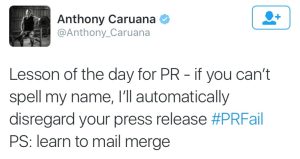
Don’t contact a reporter by phone, LinkedIn or Twitter if you know they prefer email. Use their preferred method of communication and stick to it.
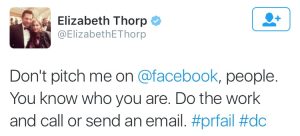
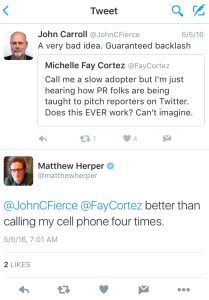
by Julie Donnelly | Aug 31, 2016 | Blog
We recently wrote about PR tips from the Donald, whose strategy continues to be, it seems, any PR is good PR. It baffles many media watchers how Trump can continue to enjoy broad public appeal even when many of his statements turn out to be less than 100 percent truthful.
One of Trump’s secrets is that he’s been able to carefully cultivate a reputation for candor. He speaks directly, and holds nothing back, or so it seems. He keeps talking to any reporter that will listen and he always has an answer (except about those tax returns).
This is in stark contrast to how Hillary Clinton has sometimes dealt with the media. In my experience covering her as a reporter when she was a New York Senator, it was extremely difficult to get her to make any substantive comment. Her defensive posture towards the press included tactics like filling the Senate elevator with her staff, so no reporter could jump on for an exclusive two-minute interview. I often wonder if Secretary Clinton would have received better press over the years if she had been slightly more open.
So I understand why Trump is catnip for reporters. Having also worked as a business reporter, I often encountered CEOs who were so reluctant to utter a single opinion, prediction, or colorful deal detail that interviews became painful tug of war exercises where no one wins. I had no story, and I was unlikely to call that CEO again, so he or she lost out on potential coverage in the future.
Caught in the middle of this tug of war is the public relations agency, which is keen to provide coverage opportunities and may be blindsided by how close-lipped the CEO turns out to be once the tape is rolling.
The solution is for company leadership, under the gentle guidance of its PR agency, to learn to be more candid, within reason. There is a wide swath of territory between the loquacious Mr. Trump and the reticent Secretary Clinton. It’s territory worth exploring to build trust, establish rapport and lay the groundwork for coverage when it counts. Learn how to be a candid CEO and reap the rewards.
- Come clean with your PR team
There probably are many things you don’t want to share with the media, but opening up to your PR team will enable them to guide interviews around sensitive topics. Are you facing a potential merger, departing CFO, or product recall? We need to know, sooner rather than later. Your PR team can help determine whether a potential negative piece of news can in fact be turned into a turnaround or redemption story. For instance, a divestiture of a non-core business may be an indication that a leadership team is laser-focused on expansion of its core product. A less than stellar third quarter may mask an overall growth trajectory if three delayed deals will close in December.
- Review what is in the public domain
There is nothing more frustrating, for a reporter, than a CEO’s refusal to answer a question on a topic that has already seen the light of day via a regulatory filing, news release, etc. On the other hand, there may be news already out there for instance in a dense proxy, or in a rival’s lawsuit that the reporter hasn’t seen. The CEO may be able to gain candor points by talking about a completed hire or deal instead of one that is still in the works.
- Use the whole animal
Remember that new details about old news are considered new news! In today’s 24-hour news cycle, many reporters are expected to submit multiple posts per day. A couple of new colorful details can extend the news cycle on an old story while gaining candor points along the way. Reporters love to get the backstory.
- Offer a trade
When my three-year-old whines that another kid won’t share a toy, I tell him to get smart. Find another toy the kid may want and offer a trade. Don’t want to talk about a product launch delay? Maybe you can instead offer a unique insight on the unintended consequences of a new regulation. Reporters love unintended consequences.
- Occasionally, be vulnerable
Once I interviewed a famously candid CEO of a health IT company for a profile. Throughout the interview, his internal PR team chewed their fingers off, as the CEO lobbed expletives at a high profile health care system and then rehashed his complicated childhood and messy divorce. But I didn’t include those details in the profile, I didn’t need to. These raw tidbits helped me to understand what drove him as a healthcare executive and I could convey that in a much more interesting way than simply airing dirty laundry. To this day, I have a pretty soft spot towards this very candid CEO.
I’m not suggesting Kardashian-level oversharing for healthcare execs on a regular basis. But letting journalists know you’re human is sometimes a good way to bring out their humanity as well.
- Say no, but nicely
Don’t shut down the interview when it wanders into uncomfortable territory. Explain gently that you can’t talk about that topic. If it’s news that will soon be public, offer the reporter an exclusive second conversation. Or if fielding several requests for comment, you could promise to release the news to everyone simultaneously via conference call.
- Realize reporters are reporters
In the end, reporters will report on what they want to, with or without your participation, as long as they are able to get sources to talk. There are some companies that are airtight, leak proof ships. But if a deal involves another company, there could be leaks there. Lawyers, accountants and other vendors are also frequent targets. As one former colleague told an angry CEO who refused an interview (only to find the story in the paper anyway) I don’t have to ask permission to publish news.”
- Get some advice
The bottom line is that CEOs must decide for themselves, do I want to let others tell my story, or do I want to tell it myself?
How effectively you tell your story will depend on scores of variables everything from your tone of voice, to your appropriate use of humor, to the color of your shirt or blouse. Luckily, there is no reason to reinvent the wheel. An investment in media training, for instance, can help leaders ready to make the leap to candid CEOs to project the kind of candor that will endear them to reporters, elevate the brand, and optimize opportunities to transmit the company message to key audiences including customers, potential leads, shareholders, potential investors and the public.

by Ken Krause | Aug 24, 2016 | Blog
One of the most persistent myths in public relations is the concept of the global PR agency. As it’s generally thought of, a global PR agency would be one where a homogenous team of like-minded PR experts spread out in offices all over the world works together to deliver outstanding, cohesive results in every market where a company has a presence.
You can put this one right up there with Bigfoot, unicorns and the idea that you don’t need a good story to achieve great PR results, you just need the right contacts.
While it would be nice for organizations with a global footprint if such a PR Valhalla existed, it simply isn’t reality. That isn’t to say there aren’t a lot of offices around the globe that share a corporate identity, and maybe an accounting department. But if you’re thinking that the non-U.S. offices will be the same as the U.S. office, just with a different address, you’re setting yourself up for a fall. Let’s look at some of the reasons why.
Two basic types of global presence
There are two basic options for creating a global PR agency with headquarters in the U.S. One, obviously, is to run everything from the U.S., from the same building. No one really does that for a host of reasons, but it’s possible you could.
Having everyone in one U.S. office would theoretically make it easier to share information about clients, what story pitches are working, new developments and discoveries, etc. Only you wouldn’t have everyone in the same place at the same time because global business is conducted in many different time zones, and the team servicing a particular region would have to be in the office during business hours for the region. So there’s really no advantage there.
Not to mention the fact that a lot of PR is understanding how stories affect people locally. Like politics, all PR is local. Despite all the advances in technology it’s tough to get a feel for the culture and the day-to-day rhythms of a region when you’re thousands of miles away.
That’s why the more common model is to establish offices within countries or regions (depending on the need and available funding) and staff them with people who speak the language(s) and understand the nuances of the culture and the way business is conducted there.
A good example is the U.K. One of the peculiarities of PR in the U.K. is that readers and editors there like contests. While no one in their right mind here in the U.S. would pitch an editor on a healthcare story by suggesting a contest, it’s quite normal across the pond. I was shocked when a U.K. agency I was working with suggested this technique, but it turned out they were right and the client was happy with the results.
What you really get
Let’s assume the global PR agency you’re interested in is using model number two. Again, that’s what most do. How does this work from a practical standpoint?
Essentially, you have a completely separate group of people working in an office thousands of miles away from their U.S. counterparts. They may share a couple of clients, but both offices likely work on plenty of non-global clients that are unique to each of them as well. After all, there are only so many Fortune 1000 companies out there.
They probably have a weekly all-agency conference call, with or without the client, just to catch up. But since what works in Singapore is unlikely to work in Belgium, it’s more a call to catch up on any messaging or developments that affect the entire team, and to make sure everyone is doing something.
Certainly it’s convenient from a billing and management standpoint. Rather than having to hire and manage individual agencies, and process billing from each one, the client hires one agency that already has the staff everywhere, and receives a single, consolidated invoice. Sort of like the bundled payments model; the client doesn’t care which office gets paid what, they just pay a fixed amount and let agency management worry about the rest.
Here’s the downside of that arrangement, however. Yes, the global PR agency has offices fully staffed with locals, all ready to go. But the people in at least some of those offices may not be the sharpest scalpels on the tray. While you can complain and put pressure on if that is the case, it’s not like the agency can suddenly dump the staff and hire new people. Especially if those people are doing well for other clients.
The other risk is they may not all have domain expertise in healthcare. And while I will be the first to say it doesn’t really matter in most industries, I know from experience it does matter in healthcare. If the people in the local office don’t understand healthcare, they’re not going to be very successful no matter what other awesome skills they possess. Hiring a global PR agency with limited U.S. healthcare experience just because it has global offices might also put the core business at risk.
The global partnership approach
A better alternative, and one I’ve been a part of before, is to hire a core PR agency and then allow that agency to select and manage best-of-breed PR partners in each key region. This approach ensures there is still just a single point of contact for the client (or “one throat to choke” if you prefer), and the lead agency can also manage disbursement of funds to the partners so the client only has to issue a single check each month. Both common reasons for desiring a global agency in the first place.
The partnering approach brings additional advantages, however. The most prominent is that you’re not stuck with whatever personnel happen to be in the local market. The lead agency can review the qualifications of several agencies and select the one that appears to be the best fit. If it’s not working, they can easily cut ties with the first agency and select a new partner.
It also preserves the relationship with a lead PR agency that has been doing well, ensuring there are no interruptions in coverage. No sense going through the entire learning curve and ramp-up period again if you don’t have to.
As for the rest of what a global PR agency brings, the partner approach offers all the same capabilities. All the partners can share information electronically, participate in global conference calls and generally work as a team. The only material difference is they won’t have the same name on the door in every office. That hardly seems worth paying a premium for, however.
Beware the myth
The myth of the global PR agency is pervasive. But the reality tells a different story. At the end of the day, it’s not about whether all the participants share a CEO. It’s whether they can promote your messages and stories in a way that delivers the coverage you need to achieve your business goals. Using an agency partnering approach instead of a single, global PR agency gives you your best chance of making that happen.
What have your experiences been when it comes to global PR? What was your best experience? What was your worst?

by Stephanie Janard | Aug 17, 2016 | Blog
Confidence. When you have it, life is a panorama of possibilities. Success just seems to follow, and even the occasional failure turns into a new opportunity. As a longtime marketing and PR copywriter, I’ve noticed company success follows a similar trajectory. Highly successful companies are, without exception, led by true believers in the company’s products and mission. And they tend to prove this faith in how they deliver their marketing and PR messaging.
By the same token, organizations that doubt their value proposition do exactly the opposite like when the US Postal Service infamously sent a status report to US Congress members via Fed EX. Or when Blackberry tweeted about a new marketing launch with an iPhone.
Both are textbook examples of how fear can paralyze an inherently good offering and jeopardize future success. With that, here’s a checklist of traits exhibited by companies that do believe in their ability to radically impact the market:
- They leverage and promote what they are uniquely known for, even indeed, especially if this value proposition bucks industry norms
- They are not overly spooked by the competition. They are obsessed with delivering outstanding outcomes for their customers.
- They don’t agonize that they’re not packing enough information in a single marketing or PR piece. They are laser-focused on getting information out to enough audiences.
- They are single-minded in their mission to make their industry and their customers worlds better and put their resources to work in proving how this can be done.
Content Marketing = Messaging Confidence
So how can companies do all of the above, in a planned, strategic way? From my experience at Amendola, they are the ones most likely to dive enthusiastically into the realm of content marketing creating and strategically distributing a valuable library of information until they effectively dominate, if not own, their industry’s narrative.
I absolutely have to call out our client Health Catalyst here. The company has methodically built the definitive online knowledge hub on how healthcare organizations are creating better outcomes through, in part, analytics and other data-informing tools. Searches for various terms and trends in healthcare often lead one to the Health Catalyst website the knowledge library is that extensive and well-crafted.
Turning customers into true believers, too
Health Catalyst also leverages its vast knowledge for an annual conference that is becoming the best-known event in the healthcare analytics arena. I think that this, too, is another hallmark of the true believer who leads his or her company to success: there is constant interaction with customers. If not conferences, then smaller user groups. If not weekly or monthly face-to-face meetings, then certainly regular opportunities to connect via webinars, online forums, and more. There are newsletters, both print and electronic if not sent monthly, then quarterly. (All of these efforts, incidentally, provide your loyal customer champions with information they can take to the powers-to-be to make the case for your company.)
This leads to another trend I’m noticing companies increasingly have someone in charge of elevating customer experiences. Critically, these people work closely with customers to set benchmark targets and then help to meet or exceed them. This can greatly benefit content marketing campaigns by cultivating case studies that reveal astonishing results.
A tell-tale sign of insecure messaging
Here’s an inescapable fact about the healthcare IT industry: many companies in this space are convinced that healthcare executives and clinicians exist on a remote and humorless plane away from the rest of humanity.
You can easily see this in much of the marketing and PR messaging that churns out from these companies. It reads as if written by a robot programmed to generate only acronyms, jargon and ubiquitous claims such as “transforming operational efficiency” and “aligning business and clinical outcomes.”
That’s about the only kind of writing that will get the greenlight in a company that isn’t confident its prospects have actual emotion buttons. Or, more to the point, aren’t confident the company’s product is compelling enough to push these emotional buttons.
In his delightfully titled blog post “What HIT Writing Needs is More Cowbell” my colleague Ken Krause lays out a good case for taking a more consumer-oriented approach to writing for healthcare audiences. “At the end of the day, clinicians and HIT leaders put their pants on one leg at a time just like everyone else,” Ken reminds us.
He adds, “When physicians plunk down money for that highly coveted BWM, it’s not because of gas mileage research; it’s because they’re sure they’ll look cool driving it.”
Indeed. And these all-too-human people work in a profession that can be extraordinarily stressful, chaotic, astoundingly over-regulated, chronically under-staffed, and many other characteristics that are a recipe for howling-out-loud humor. You read that right. As comedy writing guru John Vorhous has astutely noted, the essence of comedy is rooted in truth and pain and there’s a lot of pain in delivering healthcare in today’s modern era.
That said, I’ve yet to see healthcare IT break the comedy barrier (some of us are trying), but inroads are being made in tech B2B, thanks to a series of brilliant Adobe Marketing Cloud commercials. It is very clear that Adobe knows its audience: marketing professionals. Specifically, Adobe knows what drives us insane and nails it in what are hands down some of the funniest ads I’ve ever seen.
When customers know you get them, they have more trust in buying from you. And humor is one of the most effective ways of translating this empathy. Are you confident you understand your customers true pains? Then be more confident in using humor to market to them.
Becoming more confident in your value proposition
Sometimes, all we need is a taste of success to get a big boost in confidence. Engaging in some or all of the above activities content marketing, focusing on the customer experience, cultivating more customer interactions, crafting messages that speak on a human level increases both the odds of company success and confidence in your product. Basically, these activities get the word out about your value proposition which is 98 percent of the work involved in getting this message to take root.

by Alex Whitten | Aug 10, 2016 | Blog
Honestly, before I started as a PR intern at Amendola Communications three months ago I knew relatively nothing about Public Relations.
I’m currently studying journalism at the Walter Cronkite School of Journalism and Mass Communication at Arizona State University, so while I have had some exposure to PR, I really didn’t know what it takes to work in the field day to day. I only knew how the two fields intertwined.
Add to that the challenges of having a focus on healthcare and health IT and if feels like I’m in a very demanding school when everyone else is off for the summer, simply because I’ve continued building upon what I’ve learned at school with what I have learned here. So here are a few things I have learned about PR since I started my internship.
PR Is More Complicated Than I Thought
Before my internship what I knew about the field of PR is that it includes a lot of press releases and pitch writing. In fact, my desire to learn more about the PR field is what drove me to pursue an internship at Amendola Communications. Boy, did I learn quickly that PR is a lot more than press releases and pitches. Here are a few things I learned that PR professionals do:
1. They manage social media accounts. Can you imagine being in charge of someone’s Facebook, Twitter, Instagram, LinkedIn, Snapchat and more?
2. They create content for those social media accounts, like infographics and videos.
3. They manage websites, and sometimes even manage creating them to begin with.
4. They create, gather and analyze large amounts of data. Then use that data to create strategies to use for everything else they manage.
5. They set up and do research for interviews.
6. They even help train people on how to do interviews if they don’t have experience.
7. They manage any sort of PR crisis, or as I’d like to think they’re the firemen and women that put out the fires.
8. And you know they manage press releases and story pitching.
Teamwork Makes The Dream Work
Managing all of these aspects of PR is too much for just one person to handle. To make all those social media posts roll out smoothly and assure that everything is meeting its deadline takes a team of professionals to make a company look like a PR pro. It really does take all the teamwork of the “A Team” to make sure the PR machine is running at full capacity. I can’t stress enough how important it is for everyone who is my age and in college to learn how to work in a team, as much as we all hate doing assigned group projects. It’s more important than you’d think, and very much an everyday occurrence in the working world.
It Also Takes a Wide Range of Skills
When I started studying journalism my professors told me that companies are looking for people who are well-rounded, with many different skills and abilities, rather than someone who is only trained in one thing. It really helps in the working world to know a lot about different things such as different forms of media, different computer programs and more. Now I don’t mean everyone should go out and become a jack of all trades and a master of none. You can be a jack of all trades and a master of some, but don’t spread yourself too thin.
It’s Not Impossible to Start a Business
During my time as an intern I got to sit in on calls and meetings. During them I couldn’t help but be inspired by the people I met or spoke to who had started their own businesses. It was amazing working with people who were so excited about what they were doing and so ready to get their businesses up and running with a little help from Amendola Communications. It made me realize that starting a business isn’t always a bust and that it can be a huge success.
The Healthcare System is a lot More Disconnected Than You Think
During my internship I quickly learned that most people are under the illusion that anything involving their health, such as their medical records with their primary care physician and their health information from the last time they went to the emergency room, are all somehow connected and easily accessible among different doctors and nurses, simply because we now have computers and electronic health records. Most of the time, we couldn’t be more wrong. From what I’ve learned it’s actually very difficult to transfer information between doctors and emergency rooms and elsewhere. I’ve also learned that people are purposely creating programs and companies to help correct this issue.
It Takes One Angry Person to Cause a Healthcare PR Crisis
At one point during my internship I helped one of my supervisors make a vlog about “How to Handle a Healthcare Media Crisis.” At the moment, I understood the topic but I didn’t realize just how important it was. Until someone close to me had a medical emergency where something went wrong. Obviously they were angry and about to go on a social media rampage, when a lightbulb went off in my head. I immediately thought “this is what the vlog is about, this is why it’s important.” In our world of social media, all it takes to damage a healthcare or health IT’s reputation is one angry Facebook post to trend. Trending happens so quickly, and as stated in the video, most healthcare or health IT companies don’t even get a chance to comment on what has happened before it is too late. This is possibly one of the most important things a PR team handles.
In Conclusion
As my internship starts to wind down due to school starting I’m glad I was able to learn so much about PR, along with building upon what I already knew, from Amendola Communications. Going back to school I feel like I have a much better understanding of the PR field, and even my own field and how to interact with PR even better. In addition I now know more about healthcare and health IT than I had ever expected. At school I feel like I’ll be able to give some good insights to my fellow students about how we will be using what we’ve learned, and what we need to prepare for once we all enter the working world.
Overall, I’m happy that I got the opportunity and experience of being a PR intern at Amendola Communications. It really made me feel reassured that what I am studying and learning at school is very important and what I really enjoy.
(All GIFS courtesy of GIPHY.com)














